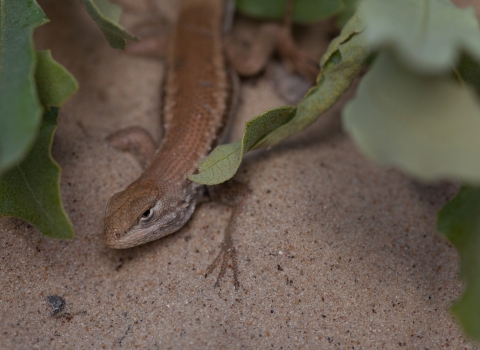The U. S. Fish and Wildlife Service’s National Wildlife Refuge System is collaborating with the USGS-led USA National Phenology Network (USA-NPN) and its online phenology monitoring program, Nature’s Notebook (nn.usanpn.org), to monitor phenology throughout the Refuge System. Through this partnership the Valle de Oro National Wildlife Refuge (NWR) has been selected as a pilot site to demonstrate the scientific and community benefits of the Nature’s Notebook program.
In October 2013, four staff members from the USA-NPN, including Executive Director and USGS Ecologist Jake Weltzin, Science and Applications Coordinator Carolyn Enquist, Education Coordinator LoriAnne Barnett, and Liaison to the US Fish & Wildlife Service Erin Posthumus, visited the Refuge to kick off the pilot project. They were joined by USFWS Inventory & Monitoring Chief Jana Newman.
“We are excited to partner with the refuge system on this pilot, ” said USGS Ecologist Jake Weltzin, “and we’ll apply lessons learned as we work to implement phenology monitoring at other refuges across the nation. ” During the visit the group had a chance to meet with Refuge Manager Jennifer Owen-White to tour the refuge and map out a potential plan for monitoring. The group also met with volunteers from a variety of organizations, including Master Naturalists, Master Gardeners, the Rio Grande Nature Center, and the Albuquerque BioPark, who will be directly involved with monitoring phenology on the refuge and communicating their findings to the public.
“Participating in the program is a way for me to make a small contribution to the community that I live in, ” said Volunteer Sandra Schwanberg. “The refuge is a beautiful place. Something interesting is always going on. There are different experiences each time I visit. Being outside, seeing small changes and working with others is enjoyable. There is always something to learn and something to share. ”
During their visit, the team from USA-NPN and FWS also visited with seniors at Nex+Generation Academy, a local high school who will be involved with the pilot as part of a school project. The senior class has already conducted an analysis of the refuge and chosen sites U. S. Fish and Wildlife Service for monitoring. The information collected by the public will be used to help refuge staff to compare the current wildlife; plants and habitat on the refuge, to the refuge after restoration activities have taken place, such as the re-establishment of wetlands. Data is collected through phenology observation and recording of environmental conditions.
“This is a great example of how phenology monitoring is being used to inform management decisions and we are excited to support this effort, ” said USFWS Inventory & Monitoring Chief Jana Newman. The study of Phenology helps biologists to understand the health of species and ecosystems by studying how plants and animals are influenced by their environment, by seasonal and yearly variations in climate, as well as other factors. Phenology helps to determine how changes will impact species abundance, distribution, interactions, carbon and water cycles, agriculture, and the ecosystem services that ultimately benefit the human population. Valle de Oro NWR, the Southwest’s first urban wildlife refuge, is unique within the refuge system in the Southwest Region because the intention behind the refuge which is not only to preserve nature, but also to involve the community from the ground up in the wellbeing and planning of the Refuge. Through its partnership with the Nature’s Notebook program, Valle de Oro NWR will represent a model for how phenology monitoring can assist National Wildlife Refuges with their management and outreach goals in the future.
“If you want to develop a relationship with the natural world, this is a good place to begin. If you have interest in plants, birds, animals, weather patterns or want to develop a connection to nature, this is a place where people can help during a time that the refuge is developing. Information from observations will be used for program planning and refuge management, ” said Schwanberg. “Come join us; learn, contribute, enjoy. ” Community members in Albuquerque have the opportunity to assist refuge management in the observation of the natural world, while collecting data for management purposes as well as public outreach. To get involved with the pilot phase of this project, contact Refuge Manager Jennifer Owen-White at 505-248-6667.



